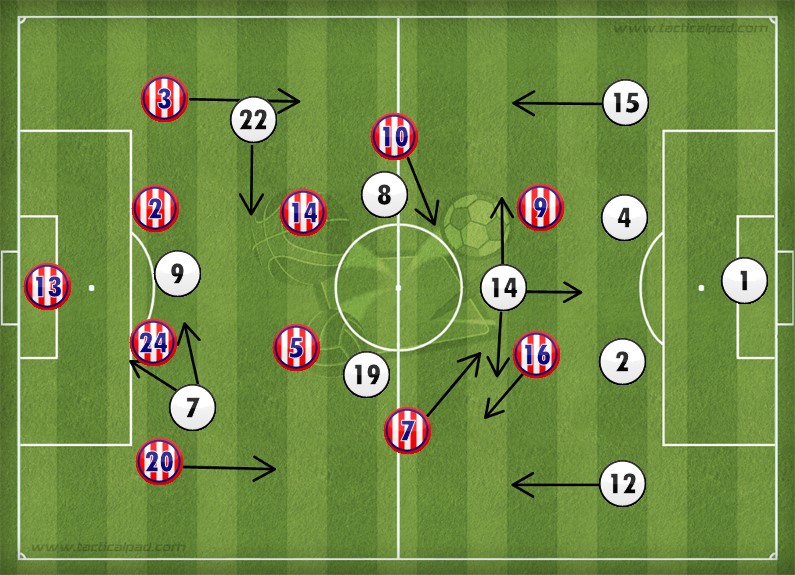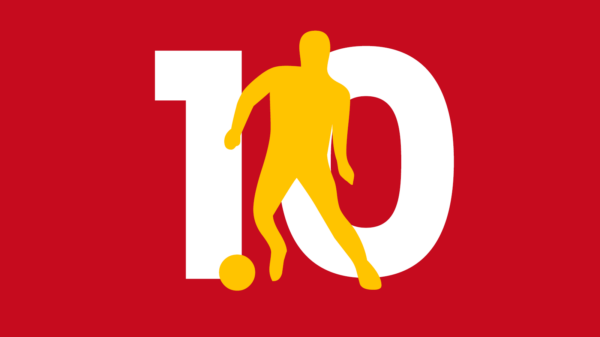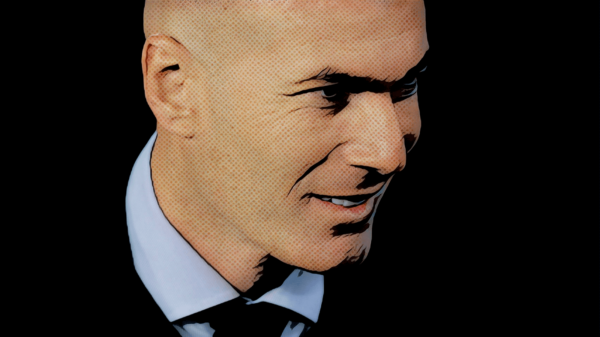In the ninth Madrid derby in just 14 months, Atletico and Real played out a stalemate with chances few and far between throughout the game. Both teams will be looking to finish in the upper reaches of the league table this season; however it is far too early in the season for this to be considered a title decider. Although grabbing the initiative and seizing top spot in the league could prove pivotal come May, neither Real nor Atletico were fussed about grabbing the three points at the Vicente Calderon. This was distinctly evident in their respective set-ups with both teams unwilling to go for the jugular and really dominate the game. Both teams looked to press high in the opposition’s build-up phase and remain compact which made it difficult for either side to gain superiority in the centre of the field. As a result of this, the wide areas were the avenue which both teams looked to exploit as the middle was so compact. Despite being almost devoid of chances for large periods, the game was still an intriguing one mainly due to the tactical choices by both managers and Atleti snatching an equalizer at the end through Luciano Vietto.
Atletico 1-1 Real Madrid

Atletico (4-2-2-2): 13. Oblak // 20.Juanfan, 24. Gimenez, 2. Godin, 3. Filipe // 5.Tiago, 14. Gabi // 7. Griezmann, 10. O.Torres // 16. Correa, 9. Torres
Real Madrid (4-3-3/4-1-3-2): 1. Navas // 15. Carvajal, 4. Ramos, 2. Varane, 12. Marcelo // 14. Casemiro, 8. Kroos, 19. Modric // 22. Isco, 7. Ronaldo, 9. Benzema
Substitutions: 46’ Ferreira Carrasco (O.Torres), 58’ Vietto (Correa), 64’ Martinez (F.Torres) // 42’ Arbeloa (Carvajal), 66’ Bale (Isco), 77’ Kovacic (Benzema)
Real’s peculiar shape: the good and the bad
Before kick-off and judging by the starting line-up, it looked as though Benitez’s men would set up in a 4-2-3-1 formation however due to the positioning and movements of Ronaldo, Isco and Modric their shape looked more like a 4-3-3/4-4-2 in attacking phases and oddly, a 4-1-3-2 shape in the defensive phase; a system which has not been often deployed by this Real side.
Ronaldo’s evolution from a pure winger to a natural no.9 has been on the cards for a number of years now in an attempt to compensate for his inevitably declining physical prowess and his impeccable movement in the 18-yard box. Despite appearing to start on the left wing in this game, he almost exclusively positioned himself in the 9 and 10 spaces, rarely moving into the wide areas except when needing to create wide combinations with Marcelo and Modric. On occasion he could be found (along with Isco) in between Atletico’s defensive and midfield lines, attempting to take advantage of the criminal amount of space (more on that to follow). The image below illustrates some of Ronaldo’s movements during the game.
Although originally starting out wide, neither Ronaldo nor Isco remained there. They both frequently roamed into the centre in order to receive possession and allow Real to achieve numerical superiority. These sorts of opportunities arose throughout the game however they were unable to turn them into chances created and bring the ball into the 3rd and 4th phase due to poor connectivity. As you can see in the image there are large amounts of space between the Madrid players making them unable to create short passing combinations. Often times they would go for the direct ball which would be intercepted allowing Atleti to intercept and counter-attack.
It was clear that Ronaldo was functioning as a no.9 although occasionally dropping deep but less so as the game wore on, instead he looked to sit on the shoulder of the last defender, providing Real’s attack with depth. Although it seems unnecessary for both forwards to stay on the last defender, both Ronaldo and Benzema were individually capable of unsettling the Atleti back 4 with their pace and intelligent movement; therefore logic would dictate that one of them drop deep to link the midfield and attack, giving them greater connections in the final third.
His and Isco’s narrow positioning did allow Real to use the full-backs even more, which was their main source of chance creation in this game. Simeone’s men are notoriously known for being ridiculously compact in their defensive phase, which would mean increased space out wide for the Real Madrid full-backs Marcelo and Carvajal. This was accentuated even more by the two Madrid ‘wide men’ whose narrowness distracted the attentions of the Atleti full backs.
The image above depicts this perfectly. Ronaldo (circled) has deviated from his left-wing position, Juanfran is unlikely to track him as he must maintain his position in the Atletico defensive block. Ronaldo’s decision to position himself centrally has distracted the attention of the full-back and left Marcelo in acres of space. It became clear very early on that Madrid were going to use this tactic regularly due to Ronaldo’s central orientation and Marcelo’s tendency to bomb forward, more so than Carvajal; who in all fairness did set up the goal for Benzema in the 9th minute.
Below is the shape/structure of both teams before Benzema’s opener. Atletico are set up in a deep 4-4-2, however their narrowness can easily be exploited. Madrid’s positional structure is near perfect in the lead up to this goal. Originally, the ball starts on the left flank with Marcelo but Real switch the play rapidly to the other flank thanks to the V shape they have employed. Instead of just a direct switch of play, this is less predictable and does not allow Atleti to anticipate a switch and shift accordingly. One must also remember, though, that Isco’s presence in the half-space is what makes this goal possible as it creates space and time for Carvajal. Oliver Torres on Atleti’s right wing does not have access to Carvajal as he is too far away and being occupied by Isco. His positioning creates space out wide for the Real Madrid right-back who plays in a cross for Benzema to head home.
Although Ronaldo’s narrow positioning did prove problematic at times, particularly in defense and in transition. The team tended to lack balance down Ronaldo’s flank as Marcelo was often isolated, add to that his propensity to support attacks and Real’s left hand-side was almost completely exposed. In order to compensate for said lack of balance, Real reverted to a 4-1-3-2 in defensive phases with Casemiro as the 6 situated in front of the back 4.
The two images above are perfect examples of Real’s vulnerability in their defensive shape, primarily caused by Ronaldo functioning as a no.9. Atleti found it so easy to switch the play and/or play it out to their full-back to relieve pressure as they were assured he would be in acres of space. In the bottom image, Oliver Torres switches the play to right-back Juanfran with ease. Real’s midfield quartet has shifted to the right leaving the left side unprotected. Juanfran had an almost infinite amount of time to run onto and receive the ball due to Real lack of protection out wide. Had Ronaldo been more conscious defensively or had Benitez told him to drop deeper and join the midfield shape, they could have changed to a 4-1-4-1 which is much more defensively secure and covers the wide areas as well as the centre. However, managers down the years have realized that Ronaldo’s strengths do not lie in his defensive capabilities but his goal-scoring exploits. Nowadays, he is almost exempt from defending, focusing solely on troubling the opposition defence. His presence up front can help Real to an extent as full-backs are reluctant to push forward when he is out wide and defenses are unable to push up their defensive line as they are well aware of Ronaldo’s ability to punish them in transition.
Luka Modric often had to compensate for Ronaldo’s central positioning, moving wide on occasion in order to create balance. Although this had repercussions elsewhere; Real on occasion were unable to gain numerical superiority as Modric had deviated from his central position.
Judging by his heat map it is clear to see that he was often on the left covering for Ronaldo. The lack of an extra body in the centre did affect Real’s defensive transition, though; Atletico found it fairly easy to break through the centre of the field with Modric out wide.
Atletico win the ball here and are able to break through the middle with such ease as Modric has left his central position to put pressure on Juanfran. As a result, Atletico now have two players between the lines and none of the 7 Madrid players in the middle are able to win the ball back as a result of their poor positioning.
High press from both sides, massive space between lines
Despite both teams setting up cautiously, they still attempted to press high in the 1st defensive phase. However, their pressing relied more on pressing traps and intelligent positioning rather than sheer numbers and intensity. Both sides would leave the wide area open, making the other think that they could relieve pressure or that they had an escape pass before initiating the press. This is where I feel Atleti looked most dangerous with their goal and a number of the chances they created coming from winning the ball high up the pitch. This made their decision to sit deeper after going behind all the more peculiar, although it is understandable to an extent as Ronaldo and Benzema’s pace in behind is a worry and it is virtually impossible to press high for the entirety of the game.
Real employed a pressing trap on occasion during the game with Juanfran in the image above (red square) appearing to have space and time on the ball only to have pressure placed on him by Benzema and Modric. Although it did not prove effective as Real were too narrow and Atleti were able to switch play.
Atletico’s press which eventually led to their goal was much more effective due to the half-space positioning of Griezmann and their overloading of the Madrid’s left hand side.
The main difference between both images is that Atletico have made it difficult for Real to switch the play like they did when Real tried to press them. Griezmann’s positioning makes sure of that as he has access to Marcelo on the left shutting him out as an option. Jackson Martinez has Ramos in his cover shadow and there is a loose man marking system in the centre of midfield. In the end, Real have no choice but to play it to Arbeloa who is immediately pressed by Carrasco.
This high press from both teams did result in a ridiculous amount of space between the midfield and defensive lines of both teams. Both teams were guilty of letting this occur, but neither truly took advantage of it due to poor connectivity and positioning. The blame mainly lies at the feet of the midfielders who are primarily responsible for linking defense and attack. They did not stagger their players effectively between the lines and take advantage of the opportunity to create superiorities in these areas. There seemed to be a lack of patience in the build-up phase for both sides, both seemed too eager to transfer the ball to the feet of the strikers without first building a stable phase of possession.
In the image above Atletico lose possession in spite of there being large amounts of space between 3 (yes 3!) or Real Madrid’s lines. The question marks show areas which players could have occupied to allow Atleti to circulate the ball more proficiently. I felt that Tiago and Gabi often occupied the same horizontal lines of play and there was a lack of variety in the roles they played despite the fact that Gabi was supposed to be functioning as the anchor and Tiago more in the box-to-box role; although at 34 years of age one questions whether he is still physically capable of performing such a role. In this image, there are only two players between the Real Madrid lines, the two 6s. The problem here is that they are far too close to each other, making the Atletico build-up more predictable and giving the Real attackers less space to cover. If Gabi were to move out of Ronaldo’s cover shadow and in between him, Kroos and Modric, he may have been able to drag one or even all 3 of them towards him creating space for Correa on the right. Tiago moving in between the Real midfield also would have proven effective as it would have given them a greater connection to the attack. In the end Gimenez at centre-back decided to play directly to Correa but the pass was intercepted and the move broke down.
Los Blancos made similar mistakes in their build-up phase with Ramos deciding not to play it direct to Ronaldo between the lines. Instead they spend too much time circulating the ball and Atletico regain compactness. At times it seemed as though both teams went for the safe option too often instead of looking to penetrate the opposition block.
Where does this leave them?
For these two city rivals, failing to get one over each other will leave a bitter taste in their mouths, although neither side have a reason to be too disappointed as it was always going to be a close game. Real may be more irked by their inability to see out the game in the final minutes and missing the opportunity to put a bit of daylight between them and Barcelona, however their performance was a lot better than their last league fixture in the Vicente Calderon when they humiliated 4-0.
A very good performance from los Rojiblancos, who look like serious title challengers again on paper after a summer of heavy investment. Although a run of 3 games without a win in all competitions is worrying for the 2014 Liga BBVA champions who are enduring their worst start to a season since Diego Simeone took over.
Written by Miles Olusina
- Scout Report: Marcus Thuram | Gladbach’s attacking sensation - July 17, 2020
- Tactical Philosophy: Paulo Fonseca - May 28, 2020
- Maurizio Sarri at Chelsea: Tactical Approach & Key Players - September 5, 2018






































































